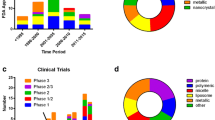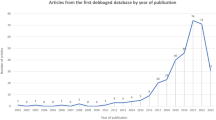Abstract
A Translational Research Symposium was organized at the 2014 annual meeting of the European society for biomaterials. This brought together leading Tier one companies in clinical biomaterials and medical device markets, small and medium enterprises and entrepreneurial academics who shared their experiences on taking biomaterials technologies to commercial endpoints, in the clinics. The symposium focused on “Progressing Innovation in Biomaterials. From the Bench to the Bed of Patients”. The aim of the present document is to illustrate the content of the symposium and to highlight the key lessons from selected lectures.
Similar content being viewed by others
References
Dees JG. The meaning of social entrepreneurship. 1998. http://csi.gsb.stanford.edu/the-meaning-social-entrepreneurship%20.
Saver JL, Jahan R, Levy EI, Jovin TG, Baxter B, Nogueira RG, et al. Solitaire flow restoration device versus the merci retriever in patients with acute ischaemic stroke (SWIFT): a randomised, parallel-group, non-inferiority trial. Lancet. 2012;380(9849):1241–9.
Larsson S, Procter P. Optimising implant anchorage (augmentation) during fixation of osteoporotic fractures: is there a role for bone-graft substitutes? Injury. 2011;42:S72–6.
Namdari S, Rabinovich R, Scolaro J, Baldwin K, Bhandari M, Mehta S. Absorbable and non-absorbable cement augmentation in fixation of intertrochanteric femur fractures: systematic review of the literature. Arch Orthop Trauma Surg. 2013;133(4):487–94.
Bajammal SS, Zlowodzki M, Lelwica A, Tornetta P, Einhorn TA, Buckley R, et al. The use of calcium phosphate bone cement in fracture treatment. J Bone Joint Surg Am. 2008;90A(6):1186–96.
Kurien T, Pearson RG, Scammell BE. Bone graft substitutes currently available in orthopaedic practice The evidence for their use. Bone Joint J. 2013;95B(5):583–97.
Fu RW, Selph S, McDonagh M, Peterson K, Tiwari A, Chou R, et al. Effectiveness and harms of recombinant human bone morphogenetic protein-2 in spine fusion a systematic review and meta-analysis. Ann Intern Med. 2013;158(12):890–902.
Hannink G, Wolke JGC, Schreurs BW, Buma P. In vivo behavior of a novel injectable calcium phosphate cement compared with two other commercially available calcium phosphate cements. J Biomed Mater Res B. 2008;85B(2):478–88.
Richards RG. Institute Davos within the AO foundation: a model for translation of science to the clinics. J Orthop Transl. 2013;1:11–8.
Lysaght MJ, Hazlehurst AL. Tissue engineering: the end of the beginning. Tissue Eng. 2004;10(1–2):309–20.
Meinig RP, Buesing CM, Helm J, Gogolewski S. Regeneration of diaphyseal bone defects using resorbable poly(l/dl-lactide) and poly(d-lactide) membranes in the Yucatan pig model. J Orthop Trauma. 1997;11(8):551–8.
Meinig RP, Rahn B, Perren SM, Gogolewski S. Bone regeneration with resorbable polymeric membranes: treatment of diaphyseal bone defects in the rabbit radius with poly(l-lactide) membrane. A pilot study. J Orthop Trauma. 1996;10(3):178–90.
Castillo-Dali GV-CR, Serrera-Figallo MA, Rodriguez-Gonzalez-Elipe A, Gutierrez-Perez JL, Torres-Lagares D. Importance of PLGA in Scaffolds for guided bone regeneration: a focused review. J Oral Implantol. 2014. (http://dx.doi.org/10.1563/AAID-JOI-D-13-00225).
Webber MJ, Khan OF, Sydlik SA, Tang BC, Langer R. A perspective on the clinical translation of Scaffolds for tissue engineering. Ann Biomed Eng. 2014;. doi:10.1007/s10439-014-1104-7).
Hollister SJ, Murphy WL. Scaffold translation: barriers between concept and clinic. Tissue Eng B. 2011;17(6):459–74.
Madry H, Alini M, Stoddart MJ, Evans C, Miclau T, Steiner S. Barriers and strategies for the clinical translation of advanced orthopaedic tissue engineering protocols. Eur Cells Mater. 2014;27:17–21.
Author information
Authors and Affiliations
Corresponding author
Rights and permissions
About this article
Cite this article
Bayon, Y., Bohner, M., Eglin, D. et al. Progressing innovation in biomaterials. From the bench to the bed of patients. J Mater Sci: Mater Med 26, 228 (2015). https://doi.org/10.1007/s10856-015-5562-8
Received:
Accepted:
Published:
DOI: https://doi.org/10.1007/s10856-015-5562-8




